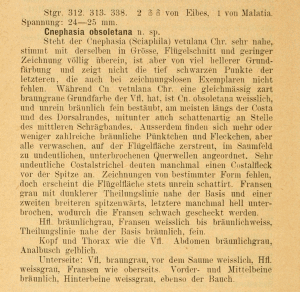

 +4Kontinente:EUAS
+4Kontinente:EUAS3. Weitere Informationen
3.1. Synonyme
- Cnephasia obsoletana Kennel (1901) [nom. praeocc.]
3.2. Nomenklatur
Kennel (1901: 230) beschrieb seine "Cnephasia obsoletana n.sp." ordentlich, übersah dabei aber, dass er ein primäres Homonym produzierte und damit einen ungültigen Namen. Erst Obraztsov (1956: 116) korrigierte das und schuf einen Ersatznamen: "C. kenneli nom. nov. * (90) obsoletana (non Wood) KENNEL, 1901, Iris, Bd. 13, (1900), S. 135. 230 (Crephasia; nom. praeocc.). — KENNEL, 1910, S. 212, t. 11 Abb. 1 (♂)." Für was der Ersatzname galt, war damit klar, aber was war mit "obsoletana (non Wood)" gemeint ? Die einzige von Obraztsov (1956: 345) zitierte Arbeit von Wood war dessen "Index Entomologicus" von 1839. Dort hieß es S. 148 knapp: "1003 Obsoletana Obscure Elm St. 4. p. 129 6997 Cnephasia Taken by Mr. Stephens near Ripley in Surrey, in June, 1827." Auf Tafel 33 folgte dann die Abbildung dieses Falters. Wood hatte hier aber gar keine Art neu beschrieben, sondern sich mit "St. 4. p. 129 6997" korrekt auf Stephens (1835: 129) bezogen, dessen knappe Beschreibung seiner "Cnephasia obsoletana" heute als Synonym von Cnephasia pasiuana gilt. Stephens (1835: 129) hatte darauf verwiesen, dass er das Taxon bereits in seinem Catalogue von 1829 als "6997 Cnephasia obsoletana mihi *" gelistet hatte; dort [Digitalisat auf biodiversitylibrary.org] gab es allerdings keinerlei Beschreibung dazu.
3.3. Taxonomie und Faunistik
Die umfassendste Beschreibung der Art - erstmals auch die des Weibchens - findet sich bei Alipanah (2019: 508-514); das Taxon wird dort in die longana-Gruppe gestellt und vor allem mit C. amseli verglichen. Die Autorin schreibt zur Verbreitung: "Cnephasia obsoletana was described by Kennel (1901) based on a single male specimen from the Jordan Valley, Jordan. Obraztsov (1956) recognized that the name was preoccupied and proposed the replacement name Cnephasia kenneli. In 1910 Kennel described Tortrix obsoletana from a male specimen from Eibés, Malatya in southeastern and eastern Asia Minor. According to Razowski (1965), the latter is considered a synonym of C. kenneli. The female has remained undescribed. During the present study, a female collected at the same locality as C. kenneli males was discovered in the HMIM, both sexes collected by the author in Zanjan Province." Daraus ergibt sich außer den Neufunden im Iran: "Distribution. Jordan (Jordan Valley), Asia Minor (Eibés, Malatya), Syria?, Kulscha? (Kennel 1901, 1910, Obraztsov 1956, Razowski 1965)."
Trematerra & Colacci (2023) überraschen mit dem Erstnachweis der Art für Italien und damit für Europa: "1 male, Italy, Molise, Marina di Petacciato, Campobasso, 4 m/asl, 26.V.2022, light trap, leg. M. Rasino." Zum abgebildeten Küstenhabitat ist zu erfahren: "In our case the collecting area includes a Natura 2000 site situated along the central Adriatic coast of Italy, where the last fragments of natural vegetation zonation on sandy coastal dunes and backdunes (shoreline vegetation, embryonic and mobile dune vegetation, annual Mediterranean grasses and wet dunes) are found [S.C.I IT7228221-Foce Trigno-Marina di Petacciato (Campobasso)] (Rasino et al., 2023). (Fig. II, 1)". Da hier nichts für eine einmalie Verdriftung spricht, ist von einem festen Vorkommen auszugehen.
(Autor: Erwin Rennwald)
3.4. Literatur
- Alipanah, H. (2019): An overview of the tribe Cnephasiini (Lepidoptera: Tortricidae: Tortricinae) of Iran with description of a new species. — Zootaxa 4661 (3): 501–521. [zum PDF auf researchgate.net]
- Beschreibung als Cnephasia obsoletana: Kennel, J. (1901): Neue Wickler des palaearctischen Gebietes aus den Sammlungen der Herren O. Staudinger und A. Bang-Haas. — Deutsche Entomologische Zeitschrift Iris 13 (2): 205-305.
- Nomen novum: Obraztsov, N. S. (1956): Die Gattungen der palaearktischen Tortricidae I. Allgemeine Aufteilung der Familie und die Unterfamilien Tortricinae und Sparganothinae. 2. Fortsetzung. — Tijdschrift voor entomologie 99 (3): 107-154. [Digitalisat auf archive.org]
- Stephens, J. F. (1829): A Systematic Catalogue of British Insects: Being an Attempt to Arrange All the Hitherto Discovered Indigenous Insects in Accordance With Their Natural Affinities. Part II. - 388 pp., London. [Digitalisat auf biodiversitylibrary.org]
- Stephens, J. F. (1835): Illustrations of British Entomology; or, a Synopsis of Indigenous Insects: Containing their Generic and Specific Distinctions; with an Account of their Metamorphoses, Times of Appearance, Localities, Food, and Economy, as Far as Practicable. Haustellata 4: 1-434 + pl. 33-41.
- Trematerra, P. & M. Colacci (2023): Phtheochroa apenninana, Epinotia cinereana and Cydia indivisa not yet listed in the Italian fauna, Cnephasia kenneli new to Europe (Lepidoptera Tortricidae). — Redia 106: 129-132. [PDF auf redia.at]
- Wood, W., 1839: Index Entomologicus or a complete illustrated catalogue of the lepidopterous insects of Great Britain. - London, 1832—39, 12 + 266 pp., 54 tt. [Digitalisat auf biodiversitylibrary.org]







